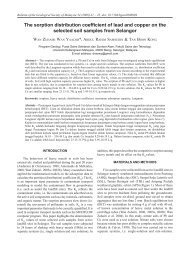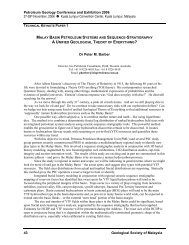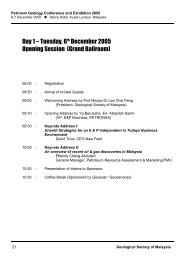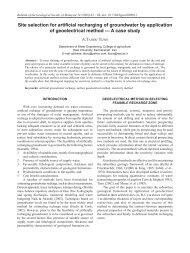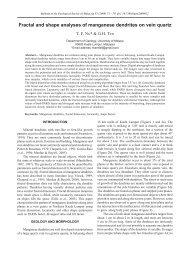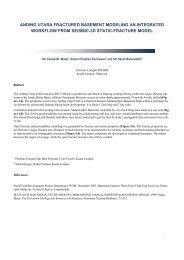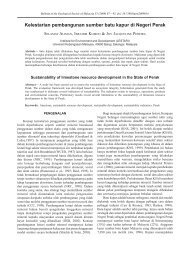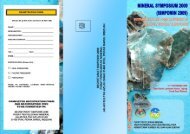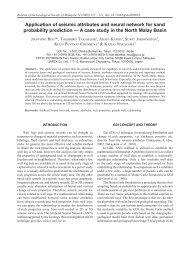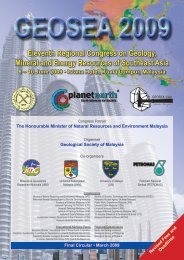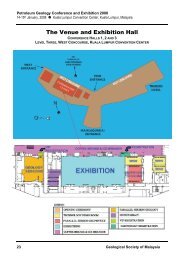The mineralogy of gold mineralization of the Ajmal Mine, Kechau Tui ...
The mineralogy of gold mineralization of the Ajmal Mine, Kechau Tui ...
The mineralogy of gold mineralization of the Ajmal Mine, Kechau Tui ...
You also want an ePaper? Increase the reach of your titles
YUMPU automatically turns print PDFs into web optimized ePapers that Google loves.
Wa n Fu a d Wa n Ha s s a n<br />
Sungai <strong>Tui</strong> a few kilometers to <strong>the</strong> north <strong>of</strong> <strong>Ajmal</strong> <strong>Mine</strong><br />
(Kee, 1990). <strong>Ajmal</strong> <strong>Mine</strong> was originally an alluvial mine<br />
working <strong>the</strong> alluvial ground <strong>of</strong> Sungai <strong>Tui</strong>. <strong>The</strong> pinnacled<br />
limestone bedrock <strong>of</strong>fers many potholes that acted as traps<br />
where rich <strong>gold</strong> concentrates were obtained.<br />
<strong>The</strong> primary <strong>gold</strong> <strong>mineralization</strong> in <strong>the</strong> area seems to<br />
be related to <strong>the</strong> igneous intrusions in <strong>the</strong> area. To <strong>the</strong> east<br />
is a small granite pluton named Bukit Damar and to <strong>the</strong><br />
north-east is <strong>the</strong> Bukit Tujuh granite. <strong>The</strong> igneous intrusions<br />
were thought to have been emplaced in <strong>the</strong> Triassic-Jurassic<br />
period.<br />
Primary <strong>gold</strong> <strong>mineralization</strong> in <strong>Ajmal</strong> <strong>Mine</strong> occurs as<br />
<strong>gold</strong>-bearing quartz veins transecting <strong>the</strong> Permian limestone<br />
bedrocks. <strong>The</strong> veins are generally steeply dipping to <strong>the</strong><br />
west (at about 70 o ) and fault-related. Some exist as single,<br />
20-30 cm thick veins while o<strong>the</strong>rs may exist as thin (a few<br />
cm) parallel veins in a shear zone (Figure 2). <strong>The</strong> faults<br />
strike approximately N-S and NE-SW.<br />
<strong>The</strong>re are two types <strong>of</strong> mineralized veins in this<br />
mine, viz., i) sulphide rich, <strong>gold</strong> poor quartz veins and ii)<br />
sulphide poor <strong>gold</strong> bearing quartz veins. <strong>The</strong> main <strong>gold</strong><br />
<strong>mineralization</strong> occurs in N-S trending sulphide-poor veins.<br />
<strong>The</strong> sulphide in <strong>the</strong> sulphide-poor veins consists mainly <strong>of</strong><br />
an olive-grey minerals later identified as tetrahedrite, galena<br />
and traces <strong>of</strong> chacopyrite and sphalerite. Gold is found in<br />
<strong>the</strong>se veins, as little specks <strong>of</strong> free <strong>gold</strong>, in <strong>the</strong> white quartz<br />
away from <strong>the</strong> main galena mass and also as little specks<br />
in <strong>the</strong> tetrahedrite. In parts, <strong>the</strong>re may also be patches <strong>of</strong><br />
galena in <strong>the</strong>se veins but <strong>the</strong> galena is a late mineral. <strong>The</strong><br />
<strong>gold</strong> was deposited earlier in <strong>the</strong> quartz, and later, toge<strong>the</strong>r<br />
with tetrahedrite.<br />
<strong>The</strong> second type is <strong>the</strong> galena-rich quartz veins.<br />
Wea<strong>the</strong>red galena appears as black material in <strong>the</strong> white<br />
quartz. Fresh surfaces show galena as medium grained,<br />
shining silvery gray scaly mineral that occurs by itself.<br />
<strong>The</strong>re may also be specks <strong>of</strong> <strong>gold</strong> grains in <strong>the</strong>se quartz<br />
veins but it occurs in <strong>the</strong> white quartz away from <strong>the</strong> galena.<br />
<strong>The</strong> galena rarely occurs with o<strong>the</strong>r sulphides. A close<br />
examination may also show <strong>the</strong> presence <strong>of</strong> a fine-grained<br />
<strong>of</strong>f-white carbonate mineral toge<strong>the</strong>r with <strong>the</strong> quartz. This<br />
carbonate, which effervesces on contact with acid, and is<br />
clean and fine-grained, probably brought toge<strong>the</strong>r with quartz<br />
by <strong>the</strong> mineralizing solution. Micro-veinlets <strong>of</strong> galena may<br />
cut both <strong>the</strong> quartz and <strong>the</strong> carbonate indicating that galena<br />
is a later mineral.<br />
Gold itself appears as minute specks in <strong>the</strong> quartz and in<br />
<strong>the</strong> tetrahedrite sulphide, but is rarely present in <strong>the</strong> galenarich<br />
part. It seems that early <strong>gold</strong> was deposited toge<strong>the</strong>r with<br />
<strong>the</strong> early quartz in <strong>the</strong> veins. A second generation <strong>of</strong> <strong>gold</strong><br />
was brought toge<strong>the</strong>r with tetrahedrite. <strong>The</strong> galena bearing<br />
late solution seems to have been depleted in <strong>gold</strong>.<br />
60<br />
Microscopic study<br />
Native <strong>gold</strong> is observed in two occurrences, viz. in<br />
white quartz and in <strong>the</strong> tetrahedrite. In both, <strong>gold</strong> is more<br />
common in <strong>the</strong> tetrahedrite-bearing quartz veins ra<strong>the</strong>r than<br />
<strong>the</strong> galena-rich variety. Sulphides consist <strong>of</strong> two major<br />
components, viz. galena and tetrahedrite. Galena seems to<br />
appear at a later stage in <strong>the</strong> <strong>mineralization</strong>, and does not<br />
carry much <strong>gold</strong>, o<strong>the</strong>r than some small <strong>gold</strong> specks observed<br />
in <strong>the</strong> galena-rich part. In <strong>the</strong> same vein, whenever <strong>the</strong>re<br />
is galena, <strong>gold</strong> specks may appear in <strong>the</strong> white quartz but<br />
not in <strong>the</strong> galena-rich part.<br />
Polished section study shows galena as <strong>the</strong> main<br />
sulphide in <strong>the</strong> galena-rich sample and o<strong>the</strong>r sulphides are<br />
rarely found. In <strong>the</strong> tetrahedrite-rich sections, tetrahedrite<br />
is <strong>the</strong> main mineral toge<strong>the</strong>r with some chalcopyrite and<br />
sphalerite engulfed by galena. Tetrahedrite boundaries in<br />
contact with <strong>the</strong> galena are rounded, convex-outwards,<br />
indicating that it has been corroded by galena and that<br />
tetrahedrite is <strong>the</strong> earlier mineral. Gold somehow appears<br />
in <strong>the</strong> tetrahedrite only and rarely in <strong>the</strong> galena.<br />
In <strong>the</strong> quartz, <strong>gold</strong> occurs as free disseminated grains<br />
along micr<strong>of</strong>ractures. Its grain size is fine, seldom exceeding<br />
1 mm. In <strong>the</strong> tetrahedrite <strong>gold</strong> appears as minute grains<br />
normally less than 1 mm maximum dimension. It appears<br />
as anhedral blebs between tetrahedrite grains and as a<br />
later mineral to tetrahedrite, as it occupies spaces between<br />
tetrahedrite grains, in places replacing parts <strong>of</strong> <strong>the</strong> earlier<br />
mineral boundary (Figure 3). Tetrahedrite in turn is an<br />
earlier mineral than galena.<br />
Polished section study under electron microanalyser<br />
(EPMA) revealed <strong>the</strong> presence <strong>of</strong> new minerals not<br />
recognized under an ore microscope. <strong>The</strong> common mineral<br />
recognized in <strong>the</strong> section is galena. <strong>The</strong> olive-grey mineral<br />
described by Cheang (1988) as tetrahedrite, is a Cu-Sb<br />
sulphide, poor in As, and was correctly identified as<br />
tetrahedrite. Less common minerals observed in minute<br />
amount are <strong>the</strong> telurides, probably petzite, and unrecognized<br />
Pb-As sulpho-salts (Figure 4).<br />
Wall-rock alteration<br />
Wall-rock alteration is hardly visible. One would expect<br />
development <strong>of</strong> new minerals at <strong>the</strong> vein quartz-limestone<br />
contact and to see calc-silicate minerals, but no such<br />
development occurs. At <strong>the</strong> vein quartz-limestone contact,<br />
<strong>the</strong>re is a narrow transition zone where <strong>the</strong> white colour<br />
<strong>of</strong> quartz is gradually changed to gray colour <strong>of</strong> limestone.<br />
An XRD analysis <strong>of</strong> a sample taken at <strong>the</strong> contact shows<br />
dolomite as <strong>the</strong> main mineral followed by quartz and<br />
calcite (Norhasfiza, 2003). <strong>The</strong> only wall-rock alteration<br />
one might expect is silicification with <strong>the</strong> addition <strong>of</strong> fine<br />
quartz to <strong>the</strong> limestone. <strong>The</strong> absence <strong>of</strong> well-defined wall<br />
rock alteration is indicative <strong>of</strong> low temperature <strong>of</strong> <strong>the</strong><br />
hydro<strong>the</strong>rmal mineralizing fluid.<br />
Discussion<br />
Gold <strong>mineralization</strong> in <strong>Ajmal</strong> <strong>Mine</strong> is significantly<br />
different from that <strong>of</strong> Penjom or Rusila (Gunn, 1994; Heru<br />
Sigit, 2002) in <strong>mineralogy</strong> as it contains less arsenopyrite<br />
and pyrite. In <strong>the</strong> latter phase <strong>of</strong> deposition <strong>Ajmal</strong> <strong>gold</strong>-<br />
Geological Society <strong>of</strong> Malaysia, Bulletin 54, November 2008



